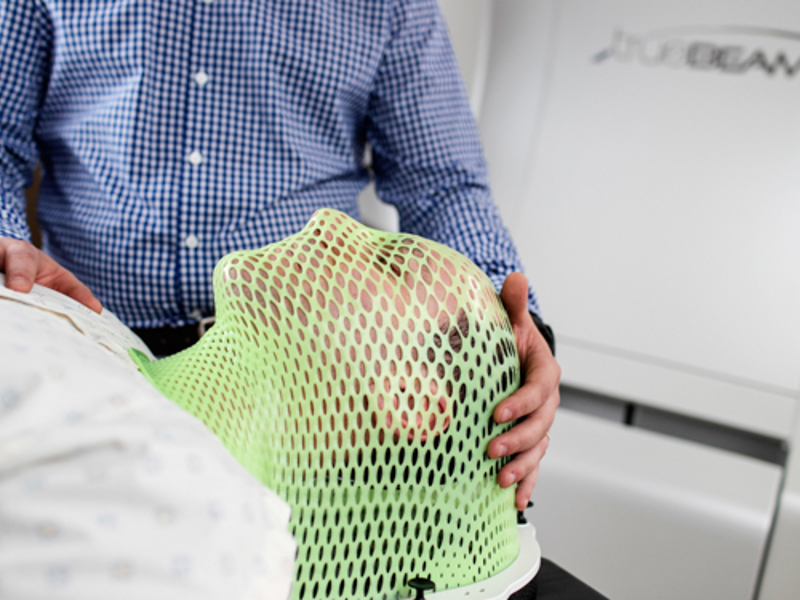What are the treatment options for head and neck cancer?
The primary treatment options for head and neck cancer include surgery, radiotherapy, chemotherapy, targeted therapies and immunotherapy. The type of treatment you receive will depend on a number of different considerations, such as the type of head and neck cancer you have, its stage, your overall health and your treatment preferences. This page aims to give you a comprehensive overview of how head and neck cancer treatment works.
Surgery for head and neck cancer
Surgery for head and neck cancer is commonly performed to remove the cancerous tissue. Depending on the area of your cancer, surgery may remove the cancer and, in some cases, surrounding healthy tissue. Reconstructive surgery (plastic surgery) may be required to help rebuild the tissue and bone that was removed.
There are many different surgical techniques that may be suitable for your head and neck cancer. The treatment you receive will depend on the type, size, stage and location of your cancer, your age and your general health.
Glossectomy
This surgery involves the removal of part or all of the tongue depending on the size of the oral cancer.
Mandibulectomy
During this procedure, part or all of the lower jaw is removed.
Maxillectomy
A maxillectomy refers to the removal of part or all of the upper jaw.
Mandibulotomy
This procedure involves the removal of cancer from the throat or the back of the tongue through the lower jaw.
Pharyngectomy
A pharyngectomy involves the removal of part or all of the pharynx.
Laryngopharyngectomy
This involves removing all of the larynx and part of the pharynx.
Laryngectomy
This involves the removal of the entire larynx and separates the trachea from the oesophagus. Following a laryngectomy, breathing takes place through a stoma in the neck and you will no longer be able to speak naturally. The thyroid may also be removed during this procedure.
Parotidectomy
During this procedure, part or all of the parotid gland is removed.
Craniofacial resection
This surgery involves removal of tissue between the eyes in the nasal cavity and is often performed endoscopically.
Orbital exenteration
An orbital exenteration involves the removal of the eye and in some cases surrounding tissue from the eye socket.
Rhinectomy
During this procedure, part or all of the nose is removed.
Endoscopic sinus surgery
Using an endoscope, part of the nasal cavity or sinuses are removed through the nose.
Reconstructive surgery
Following the procedure to remove your cancer, reconstructive surgery may be needed to assist you to breathe, eat or talk. This may involve a free flap using skin, bone or tissue, or synthetic materials such as silicone or titanium.
Lymphadenectomy
A lymphadenectomy refers to the removal of any nearby lymph nodes that may have been affected by cancer.
Head and neck surgery is typically performed under general anaesthesia. The types of surgery commonly used include:
-
Open surgery
Where a long incision is made through the skin in the neck or face to access and remove cancers.
-
Endoscopic surgery
A minimally invasive procedure that uses an endoscope which is inserted through the nose or mouth to access and remove the cancer. Endoscopic procedures result in less postoperative pain and complications, shorter hospital stay, and faster recovery compared to open surgery.
-
Trans-oral robotic surgery (TORS)
Uses a robotic system to perform surgery through the mouth remotely, allowing greater precision in comparison to endoscopic surgery.
-
Transoral laser microsurgery (TLM)
Uses a microscope with a laser attached to perform minimally invasive surgery to remove cancers through the mouth.
Radiotherapy for head and neck cancer
Radiotherapy uses highly targeted radiation to destroy head and neck cancer cells. For some types of head and neck cancer, it may be used as the main treatment instead of surgery.
Radiotherapy may be used in a number of ways:
Together with chemotherapy (chemoradiation) to make head and neck cancer cells more sensitive to radiotherapy. Surgery may or may not follow
After surgery (adjuvant radiotherapy) to help destroy any remaining cancer cells and to help prevent head and neck cancer from returning
For the treatment of more advanced head and neck cancers to help manage symptoms, such as pain or bleeding
During radiotherapy for head and neck cancer, the radiation is delivered through external beam radiotherapy (EBRT).
There are two types of external beam radiotherapy techniques that are typically used:
Another common type of EBRT used for head and neck cancer is 3D conformal radiotherapy (3D CRT).
Immobilisation masks & how they're made
If you receive radiotherapy for your head and neck cancer, you may also need an immobilisation device such as a mask to ensure you stay as still as possible throughout your treatment.

Chemotherapy for head and neck cancer
Chemotherapy uses drugs to destroy head and neck cancer cells or to stop them from growing and spreading. A combination of several different chemotherapy drugs is usually given to increase their effectiveness. Chemotherapy may be used together with radiotherapy to help make the head and neck cancer cells more sensitive to the radiation (chemoradiation) and after surgery or radiotherapy (adjuvant therapy) to help destroy any remaining cancer cells.
Common chemotherapy medicines
Common chemotherapy drugs used to treat head and neck cancers include:
-
Cisplatin or carboplatin
These chemotherapy drugs are known as platinum compounds. They may be given as chemoradiation or with a combination of other chemotherapy drugs to treat locally advanced or advanced (metastatic) head and neck cancers or some cancers which have returned. They are given by intravenous infusion every three to four weeks.
-
5-fluorouracil (5-FU)
This works by preventing the cancer cells from making the genetic material (RNA and DNA) they need to reproduce, which causes them to stop growing and die. It may be used as chemoradiation or as adjuvant therapy following chemoradiation to treat some types of locally advanced head and neck cancers. It may also be used in combination with other chemotherapy drugs to treat some types of advanced (metastatic) head and neck cancer or cancers which have returned. It is usually given by intravenous infusion every three to four weeks.
-
Docetaxol
This works by disrupting certain structures within cancer cells that are needed for their growth and reproduction, causing the cancer cells to die. It is given in combination with other chemotherapy drugs to treat some types of locally advanced head and neck cancers. It is usually given by intravenous infusion every three weeks.
-
Paclitaxel
This works by targeting certain structures within cancer cells that they need to grow and multiply, causing the cells to stop growing and die. It is given in combination with other chemotherapy drugs to treat some types of advanced (metastatic) head and neck cancer or cancers which have returned. It is usually given by intravenous infusion every three weeks.
-
Gemcitabine
This works by interfering with the DNA production within cancer cells, causing them to stop growing and spreading. It is used to treat some types of advanced (metastatic) head and neck cancers or cancers which have returned and is usually given by intravenous infusion every four weeks.
Targeted therapies for head and neck cancer
For people with advanced head and neck cancer, targeted therapy drugs can stop the cancer’s growth and spread. These drugs are delivered orally or through the bloodstream to attack specific components of cancer cells.
A common targeted therapy drug for head and neck cancer is:
Cetuximab – This is a monoclonal antibody that blocks the action of epidermal growth factor receptors (EGFR), a protein on the surface of our cells that promotes their development. Cetuximab binds to EGFR on the surface of head and neck cancer cells, blocking their growth and killing them. It may be given as chemoradiation or together with other chemotherapy drugs for advanced (metastatic) head and neck cancer or cancers which have returned
Immunotherapy for head and neck cancer
Immunotherapy trains the body’s own immune system to recognise and fight head and neck cancer cells, which may hide behind proteins known as checkpoints. It is commonly used when your head and neck cancer has spread to other areas in the body or has come back after initial treatment.
Common immunotherapy medicines
Immunotherapy drugs for head and neck cancer include:
Pembrolizumab and nivolumab – These are monoclonal antibody drugs that work by blocking certain protein receptors on the surface of cancer cells, called PD-L1 receptors, which then stimulate the immune system to recognise and attack cancer cells. They are used in the treatment of advanced (metastatic) head and neck cancer or cancers which have returned and are given by intravenous infusion every three weeks.
Clinical trials for head and neck cancer
Icon offers a wide range of clinical trials providing patients with access to new and evolving treatments. Clinical trials offer hope and opportunity and contribute to breakthroughs in treatment for future cancer patients.

Treatment by stage of head and neck cancer
When you are diagnosed with head and neck cancer, your oncologist will develop your treatment plan as part of a multidisciplinary team based on the type and stage of your cancer.
Learn more about the common options below.
Stage I and II head and neck cancer
Radiotherapy or surgery are the most common types of treatment for early-stage head and neck cancers that have not spread to the lymph nodes. Occasionally, a combination of both surgery and radiotherapy may be required.
Stage III (locally advanced) head and neck cancer
If the cancer has grown into surrounding tissue and/or spread to nearby lymph nodes, surgery is usually done with the aim of removing the head and neck cancer. This will typically be followed by radiotherapy and reconstructive surgery where needed, with or without chemotherapy. For mucosal cancer, radiotherapy together with chemotherapy is the most common treatment option.
Stage IV (advanced) head and neck cancer
Treatment for advanced head and neck cancer that has spread to other parts of the body primarily focuses on improving or maintaining quality of life when the cancer can no longer be cured. Treatment options recommended by your oncologist will typically include chemotherapy, targeted therapy, immunotherapy and radiotherapy and will be selected based on what is most appropriate for your cancer. Palliative care referral will usually be made at this stage after consultation with you. Clinical trials may be available, but they have strict entry criteria. Ask your doctor if there is a clinical trial suitable for your cancer.










